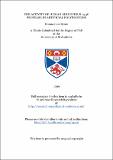Files in this item
The activity of human rhinovirus 14 3C protease in artificial polyproteins
Item metadata
| dc.contributor.advisor | Ryan, Martin Denis | |
| dc.contributor.author | Byrne, Emma Jane | |
| dc.coverage.spatial | 243 p. | en_US |
| dc.date.accessioned | 2018-06-20T10:21:31Z | |
| dc.date.available | 2018-06-20T10:21:31Z | |
| dc.date.issued | 1999 | |
| dc.identifier.uri | https://hdl.handle.net/10023/14310 | |
| dc.description.abstract | HRV14 3C acts as a protease and has a role in RNA replication in vivo, interacting with a cloverleaf structure in picornaviral genomic RNA. Picornaviral 3C proteases are able to cleave both N- and C-terminally producing 3CDpro, or, 3Cpro and 3DPol, respectively. In order to investigate the mechanisms whereby these alternative processing pathways are adopted an artificial polyprotein system was constructed, composed of viral sequences from the P3 region of the viral polyprotein flanked by reporter genes. Two antibiotic resistance genes (KanR, TetR) were cloned to act as reporter genes flanking the viral region of interest. Analysis of the cleavage products in a coupled TnT system showed whether N- or C-terminal cleavage had occurred. 3Cpro cleaved preferentially at its N-terminus in [KanR3CproTetR] with a lesser degree of cleavage at its C-terminus. When 3ABC was used as the viral component of the system cleavage at the N-terminus of 3Cpro was also observed. The use of 3CDpro as the viral component also had a regulatory effect on the site (N- or C-terminal) of cleavage by 3Cpro. With 3CDpro as the viral component of the artificial reporter polyprotein cleavage occurred at both the N-and C-termini of 3Cpro as well as at the C-terminus of 3Dpol. This surprising result has led to comparisons with the proteolytic action of viral proteases in the caliciviruses and some plant viruses and the proposal of possible evolutionary links between these viruses. The use of the antibiotic resistance genes as reporters allowed investigation into the use of antibiotic resistance phenotypes in E.coli for monitoring cleavage of the artificial polyprotein. Preliminary results indicated that the system may be useful as a genetic screen to quantify large numbers of mutants. | en_US |
| dc.language.iso | en | en_US |
| dc.publisher | University of St Andrews | |
| dc.subject.lcc | QP609.P7B8 | |
| dc.subject.lcsh | Polygalacturonase | en |
| dc.title | The activity of human rhinovirus 14 3C protease in artificial polyproteins | en_US |
| dc.type | Thesis | en_US |
| dc.type.qualificationlevel | Doctoral | en_US |
| dc.type.qualificationname | PhD Doctor of Philosophy | en_US |
| dc.publisher.institution | The University of St Andrews | en_US |
This item appears in the following Collection(s)
Items in the St Andrews Research Repository are protected by copyright, with all rights reserved, unless otherwise indicated.

